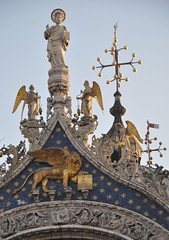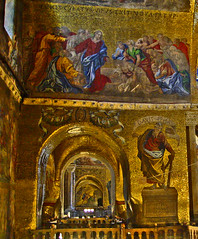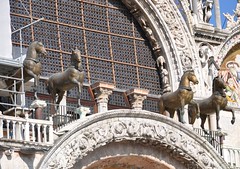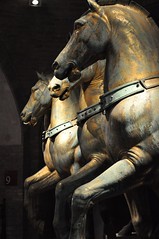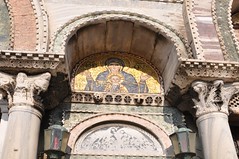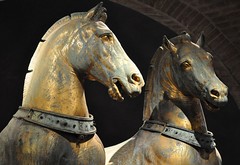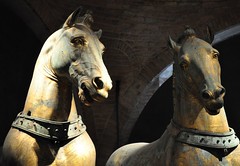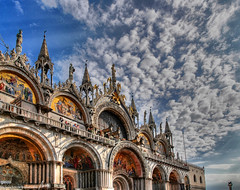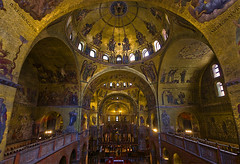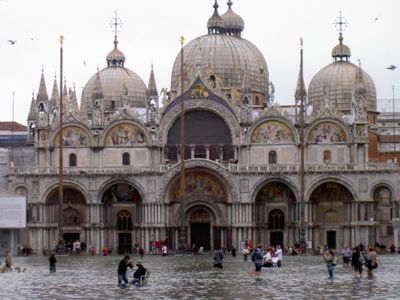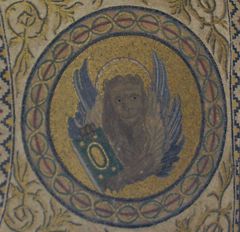The
St. Mark's Basilica is the magnificent building that is the symbol of power and the greatness of the
Venice Republic during the thousand years of the Venetian life.
It underwent many modifications over time from primary brick construction, but already set with arches that overlook the St. Mark's Square.
In 828 Justiniano Partecipazio laid the foundation of St. Mark's Basilica after he was transported from Alexandria to Venice the body of the Evangelist, by gathering the oratory of the previous church dedicated to San Teodoro.
Unfortunately, the new factory caught fire in 976, and was immediately rebuilt by the Doge Pietro Orseolo I. In 1043 Domenico Contarini carried on the work, which were completed in 1071 by Domenico Selvo, and finally Vitale Falier he made the solemn consecration in 1094.
In 1145 another fire broke out inside the Basilica, fire that destroyed part of the building high decoration.
The Church, therefore, was restored, was covered in marbles and this is probably ended only after 1159, when he also began a program of expansion of the mosaic decoration.
The frescoes were removed and the church was completely covered with mosaics. The lobby was covered in only around the thirteenth century mosaics.
If they ignore the architects, but the style that predominates is the greek byzantine with some mixture of Arabic and German. This church always remained the ducal chapel until 1807, when it became a cathedral by edict of Napoleon.
Founded as the Doge's private chapel, the
St. Mark's Basilica, with the arrival of the mortal remains of the saint in 828 and its consecration in 1094, he became the focus of the revival of these populations, boasting burial Evangelist, they took on a leading role in the Catholic tradition and became so the architects of the historical events of the time, for example by participating in the various Crusades, concentrating its energies in the trade with the East, with which they could finance the homeland construction of more buildings.
Trade is the great strength of the city. All war and diplomatic efforts have a very specific economic goal. The wars and conquests brought in Venice also the artistic culture. Not surprisingly, the
St. Mark's Basilica suffered the influences of Constantinople monuments, beginning with the
Saint Sophia Church and
Church of the Twelve Apostles, managing to blend the classical tradition with the Roman Hellenistic thought of the new early-Christian culture, keeping Ravenna references especially in the construction of the first floor mosaics. Only a few cities in the world, Rome included, they can afford to have the privilege of owning such a cospiquo number of
Medieval mosaics. Pavia, Reggio Emilia, Lyone, Reims or cologne retain only small fragments of their medieval floors.
With the gradual increase in trade with the East, the negotiating capacity of the Venetians and the consequent enrichment of local merchants, even the
St. Mark's Basilica widened, he was embellished with marble from the Aegean shores and numerous war trophies of various Eastern campaigns, among which are proudly displayed the two
Pillars of Acre raised behind the south wall of the Basilica, at the
Piazzetta San Marco.
Even the first
San Marco mosaics are the result of oriental mosaic artists who were brought to
Venice just as skilled labor from the Aegean. The only St. Mark's Basilica has a mosaic that celebrates the Basilica itself, performed in the thirteenth century, is located above the northern arch of the main facade, the mosaic of
Sant'Alipio Portal.
The central portal you can admire the mosaic that represents the Last Judgment and in the vaults of the side doors mosaics depict The transport of the Body of St. Mark , The Body of St. Mark taken from the infidels , The deposition of his remains in the Church .
On the terrace that covers the entire length of the basilica, from which you can admire in its entirety the
St. Mark's Square, the
Loggetta Sansovino, you have a vision of all the particular
Clock Tower, it is exposed the famous chariot of bronze horses. Of course the one exposed to the elements is a copy, the original of the four horses is well sheltered in the path of the
Basilica Museum which is accessed by a steep staircase in the church access side.
In 978 he was ordered, then the famous Greek goldsmiths, the Pala d'Oro, because it was exposed during the most important celebrations that were carried out in the Basilica di San Marco. It was in the centuries expanded and renovated several times, until it was just as you see it today: a magnificent Byzantine works of gold with numerous gems and enamel set around images of Jesus Christ during his apostolic period.
The Pala d'Oro should still be considered only one of the many artifacts that the St. Mark Treasury holds in its rooms. Jars of sardonic, agate jars, chalices and reliquaries with gems, cups and bowls made of rock crystal, are some of the visible objects in the museum.
The interior of the basilica has the shape of a Greek cross and is divided into three naves with five domes covered externally lead. As you enter you find yourself under the Apocalypse Arco', followed by the Pentecost Dome 'which follows the middle Dome of Ascension, before arriving at the Presbytery with the high altar raised.
Also the terrace overlooking
St. Mark's Square worth a visit. The access path are on display tapestries and precious fabrics, as well as the original of
St. Mark horses Quadriga, a copy of which dominates the main gateway to the Basilica. The walkway allows you to enjoy three of the sides of the Basilica, the
St. Mark's Square, the
Piazzetta San Marco and
Piazzetta dei Leoncini.
On the south elevation is admirable the beautiful mosaic of the
Madonna and Child, popularly known as the
Lady of Fornareto under which is kept burning a reminder of the moons Fornareto, little baker, executed innocent for a murder he did not commit.
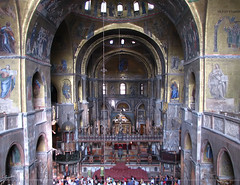
inside San Marco Basilica -

